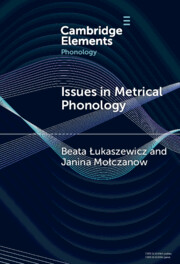Refine search
Actions for selected content:
12 results
High Central Vowels in Polish, Ukrainian and Russian
-
- Journal:
- Journal of the International Phonetic Association , First View
- Published online by Cambridge University Press:
- 21 May 2025, pp. 1-34
-
- Article
-
- You have access
- Open access
- HTML
- Export citation

Issues in Metrical Phonology
- Insights from Ukrainian
-
- Published online:
- 28 February 2025
- Print publication:
- 27 February 2025
-
- Element
-
- You have access
- Open access
- HTML
- Export citation
5 - Cultural Heterogeneity and Language Regime Transformation
- from Part I - Routes of Change
-
-
- Book:
- States of Language Policy
- Published online:
- 14 November 2024
- Print publication:
- 21 November 2024, pp 84-105
-
- Chapter
- Export citation

Heritage Languages
- Extending Variationist Approaches
-
- Published online:
- 09 July 2024
- Print publication:
- 27 June 2024
3 - The Toronto Context
-
- Book:
- Heritage Languages
- Published online:
- 09 July 2024
- Print publication:
- 27 June 2024, pp 29-36
-
- Chapter
- Export citation
5 - Cross-Variety Comparisons
-
- Book:
- Heritage Languages
- Published online:
- 09 July 2024
- Print publication:
- 27 June 2024, pp 92-158
-
- Chapter
- Export citation
8 - Indexicality in Heritage Languages
-
- Book:
- Heritage Languages
- Published online:
- 09 July 2024
- Print publication:
- 27 June 2024, pp 192-205
-
- Chapter
- Export citation
6 - Cross-Language Comparisons
-
- Book:
- Heritage Languages
- Published online:
- 09 July 2024
- Print publication:
- 27 June 2024, pp 159-166
-
- Chapter
- Export citation
Linguistic tug-of-war: regional perceptions of Ukrainian
-
- Journal:
- Journal of Linguistic Geography / Volume 12 / Issue 1 / April 2024
- Published online by Cambridge University Press:
- 09 May 2024, pp. 32-43
-
- Article
-
- You have access
- Open access
- HTML
- Export citation
3 - Beyond ‘Narrating the Nation’
- from Part I - Situated Multilingualism and Identity
-
-
- Book:
- Multilingualism and Identity
- Published online:
- 22 July 2022
- Print publication:
- 04 August 2022, pp 43-68
-
- Chapter
- Export citation
13 - Heritage Languages in South America
- from Part I - Heritage Languages around the World
-
-
- Book:
- The Cambridge Handbook of Heritage Languages and Linguistics
- Published online:
- 04 November 2021
- Print publication:
- 25 November 2021, pp 305-350
-
- Chapter
- Export citation
Rhythmic stress in Ukrainian:Acoustic evidence of a bidirectional system
-
- Journal:
- Journal of Linguistics / Volume 54 / Issue 2 / 01 April 2018
- Published online by Cambridge University Press:
- 28 November 2017, pp. 367-388
- Print publication:
- 01 April 2018
-
- Article
- Export citation
